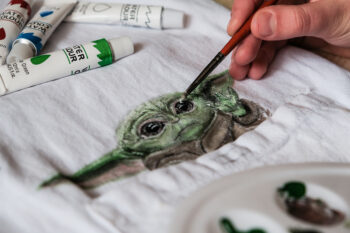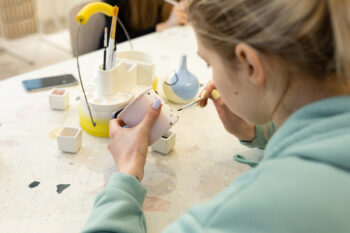Last Updated on January 10, 2023
Knowing how to seal acrylic paint correctly is important if you want things to survive for any length of time without being damaged. However, some people forget to carry out this important step, and they then wonder why the acrylic paint they have used doesn’t meet the standard they were expecting.
Fortunately, sealing acrylic paint is an easy task to follow. In fact, we will take you through the best method and explain why sealing acrylic paint is so important.
The Versatility of Acrylic Paints
Acrylic paints can be amazing to work with. Its versatility allows it to be used on a wide range of surfaces and materials. Acrylic paints can be used on wood, canvas, plastic, latex, or hardboard. The list goes on and on. However, that extensive list can cause problems.
Paint can survive and look fresh for different lengths of time on different surfaces. How acrylic paint copes with being on painted wood can be different to a less porous surface, such as plastic or latex.
That means you need to know how to seal acrylic paint on whatever you are painting on, which we will focus on next.
Sealing Acrylic Painting on Canvas
So we can start by talking about the most obvious material: canvas. You need a good sealant, and we feel a varnish sealer for this very purpose is the right approach.
This layer will protect the paint from dust and UV rays, so it will keep its natural colours for longer. Also, it gives a glossy finish to the whole painting, and that’s not a bad thing either.
You must make sure your entire painting is completely dry for this method. After that, you want to apply the varnish to the top of the painting. However, you do want to only use a brush with a wide base. You also need to apply the varnish in one direction only. Choose if you want horizontal or vertical, and then stick to it.
After that, you need to allow the varnish to dry completely. Once it has dried, you then apply a second coat to the acrylic paint, but this time you go in the opposite direction to the first coat.
The only thing you then need to do is wait for this to dry and hang up your painting.
Sealing Acrylic Paint on Wood
If you have applied acrylic paint on a wood surface, then the way you seal acrylic paint is slightly different to the canvas method mentioned above.
People apply acrylic paint to brighten up their wood crafts, but it does deserve to be protected with the same high gloss varnish or even a matte finish if required. Also, keep in mind that if you have used spray paint on wood, you will also need to follow these steps.
Step 1: Prepare the Wood Before Painting
The first thing you need to do is to prepare the wood, and you must do this before you start painting on it.
The key here is to lightly sand the wood with some fine-grit sandpaper. What you are looking at doing is simply breaking the top surface of the wood, as that will make a huge difference when it comes to protecting it later on.
After sanding, you need to wipe the surface to remove any dust and debris sitting on the wood. Once that is complete, you must prime the wood before painting, and this can be done using any priming method you choose.
Step 2: The Sealant
It is only after doing this that you can then set to work with painting the wood. Once it has been painted, you need to allow the paint to dry completely before you think about applying a clear sealant. It will be up to you regarding the sheen applied to the surface. You can also use various products, such as mod podge or any varnish protecting acrylic paint. Most can be applied to any surface, but double-check this with the product you have in mind before using it on your painted surface.
Step 3: The Coats
As we mentioned before, you need to apply the first coat of your varnish or sealant in only one direction. Use that wide base coat brush, and make sure you add a good cover of sealant without the layer is too thick.
Allow that coat to dry completely, then apply the second coat in the opposite direction. Two coats will be enough.
How to Seal Acrylic Paint on Plastic
We will now move on to telling you how to seal acrylic paint on plastic, as this is another type of surface that is popular with people doing crafts. This is usually when people decorate plastic ornaments or items, and, understandably, you want to protect the paint for as long as possible.
But once again, the sealant for acrylic paint when it comes to a plastic surface involves a different approach than what we described when telling you how to varnish an acrylic painting. This time, we don’t even recommend you use a brush to complete this task.
The Problem With Plastic
Painting onto the plastic with acrylic paints is difficult, even though you can apply the paint itself to nearly any surface. This is partly due to acrylic paints being water-based and the fact that you are putting them onto an extremely smooth surface.
Going ahead and brushing a high gloss finish on top of what you have been painting is tough, and there’s a real chance that the brush could make a mess of things. That is why we suggest something different.
Also, we do suggest you prime the plastic with the correct primer before you paint. It will help the paint stick to the surface, and then you can come in with special acrylic polymer varnishes to seal your actual painting and stop it from peeling.
Using a Spray Varnish
In this instance, we recommend using a spray varnish on the finished acrylic painting. This varnish will give the acrylic painting a clear coat, and these varnishes can seal acrylic paints in seconds.
The key here is to use the varnish in the same way as you would with spray paint. You need to keep the can around 30 cm away from the paint and spray in an even manner.
You still have the same choices available when it comes to the finish. Also, you must make sure the paint is dry before you add a thin layer.
Of course, as you use varnish or sealant in a spray can, there’s no need to always go in the same direction. However, you may need to still give it a second coat of varnish to completely protect your acrylic painting.
Sealing Acrylic Paint on Fabric
When it comes to knowing how to seal an acrylic painting on some fabric, then the good news is that it’s easier than you may have feared. Also, people don’t realise that you can put acrylic paint on fabric, but it is a surprisingly good surface for the paint. However, the colours will fade quickly without the correct sealant, especially if it is placed in direct sunlight.
As is the norm, the method you use to seal paint on this material is different to before. Also, there are a couple of options.
Option 1: Painting on Acrylic Resin Varnishes
The first option is to simply paint the varnish onto the fabric once the paint has completely dried. You want to give fair coverage, and as the varnish dries after a few hours, it should adhere to both the paint and the fabric.
Option 2: Using Heat
Another option to seal acrylic paint, which is different from the norm, is using heat to effectively set the paint into the fabric.
For this, you need to get your iron and do not put it onto the steam setting. Turn the fabric inside out, and heat press over the area. If using this method, never iron directly onto your acrylic paintings. It will simply take the paint off the fabric.
If you are worried about ironing straight onto the fabric, then tack cloth onto the reverse of the fabric. You then use the cloth as a barrier and protective shield for the paint. You then iron in small areas at a time to allow the paint to be effectively set.
Sealing Acrylic Paint on Glass
Finally, we have to look at acrylic paintings done on glass and how you seal them. As glass is a smooth surface, using the correct acrylic polymer varnish will be important.
With glass, there are two options available, and one is going to use a technique we haven’t covered so far.
Option 1: A Varnish
The first thing to mention regarding using an acrylic polymer varnish is that you should not apply this method on glass used for food or drinks. Instead, you need to use our non-toxic approach, which we will cover next.
However, if you are decorating glass ornaments, using varnish is perfect for protecting whatever you have been painting. It’s best to use a varnish you can spray on, as it means you can still give a thick coat of varnish, but there’s less interaction with the glass. A brush could push paint around if it is not 100% dry, and it will ruin all your hard work.
If using varnish, you may need to add even a third coat. If using a brush, then be very gentle.
Option 2: Oven-Baked
The second option is to bake the glass, and this is the non-toxic method we hinted at earlier.
Some acrylic paints tell you how to bake them at their best, and it’s always important to follow their instructions if possible. However, here are some general rules for you to follow.
Place the glass in a cold oven rather than a pre-heated one. It means the glass can warm up gradually, which is safer. Set the oven to around 300 degrees Fahrenheit, and bake it for 30 minutes. After that time, switch the oven off, and allow it to cool completely before opening the door.
After that, the paint should be sealed and won’t peel off.
Seal Your Acrylic Painting Properly
And that’s it for how to seal acrylic paint. The entire process is easy to follow, yet it is crucial that you do it correctly. Acrylic paint is a wonderful thing, but sealing acrylic paint cannot be avoided if you want it to continue to look amazing and vibrant.
So do yourself a favour. If you produce acrylic paintings, at least have an acrylic sealer to hand before you start. You will be glad that you did so.
Let us know if our tips have been useful by leaving a comment below!

Ian loves everything that revolves around the home improvement niche. He loves trying out new home appliances. He has also handled a lot of equipment and has a lot of insight. Plus, he’s worked on various home improvement projects that became a success. If Ian isn’t busy working on his latest project, you can find him reading up about another one!



